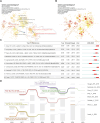Decoding the research landscape of drug resistance and therapeutic approaches in head and neck cancer: a bibliometric analysis from 2000 to 2023
- PMID: 38645557
- PMCID: PMC11026562
- DOI: 10.3389/fphar.2024.1375110
Decoding the research landscape of drug resistance and therapeutic approaches in head and neck cancer: a bibliometric analysis from 2000 to 2023
Abstract
Introduction: Head and neck cancer is one of the most common tumors worldwide. However, drug resistance in its treatment has become a major factor limiting the efficacy. This study aims to comprehensively understand the current status of research in this field.
Methods: The study analyzes papers related to therapeutic resistance in head and neck cancer published between 2000 and 2023 in the Web of Science Core Collection To achieve the research objectives, we searched the WoSCC for research and review papers on therapeutic resistance in head and neck cancer from 2000 to 2023, screened the English literature, and analyzed the research hotspots, academic collaborations, and trends in detail using tools such as Citespace, SCImago Graphica, and VOS viewer.
Results: This study summarizes 787 head and neck cancer treatment resistance publications from WoSCC. The analysis showed that China and the United States are the major contributors in this field, and Grandis Jennifer R and Yang Jai-Sing are the key scholars. Keyword analysis showed that "cisplatin resistance" is a continuing focus of attention, while "Metastasis" and "Ferroptosis" may be emerging research hotspots. Literature clustering analysis pointed out that "Ferroptosis", "Immunotherapy" and "ERK signaling" were the recent hotspots that received extensive attention and citations. Finally, we discuss the current status and challenges in drug-resistant therapies for head and neck cancer.
Conclusion: This study is the first comprehensive bibliometric analysis of drug resistance in head and neck cancer. Reveals current trends and helps researchers grasp cutting-edge hotspots in the field.
Keywords: bibliometric analysis; data visualization; drug resistance; head and neck cancer; research frontiers.
Copyright © 2024 Han, Shi, Liu, Fu, Li, Guo, Guan, Xue, Liu, Zhao and Zhang.
Conflict of interest statement
The authors declare that the research was conducted in the absence of any commercial or financial relationships that could be construed as a potential conflict of interest.
Figures









Similar articles
-
Bibliometric analysis of youth myocardial infarction research (1980-2023).Front Cardiovasc Med. 2024 Nov 26;11:1478158. doi: 10.3389/fcvm.2024.1478158. eCollection 2024. Front Cardiovasc Med. 2024. PMID: 39660115 Free PMC article.
-
Current trends and landscape of drug resistance in renal cell carcinoma: a bibliometric analysis.Discov Oncol. 2025 May 19;16(1):820. doi: 10.1007/s12672-025-02594-0. Discov Oncol. 2025. PMID: 40389616 Free PMC article.
-
Analyzing the research landscape: Mapping frontiers and hot spots in anti-cancer research using bibliometric analysis and research network pharmacology.Front Pharmacol. 2023 Sep 7;14:1256188. doi: 10.3389/fphar.2023.1256188. eCollection 2023. Front Pharmacol. 2023. PMID: 37745055 Free PMC article.
-
Research trends of ferroptosis and pyroptosis in Parkinson's disease: a bibliometric analysis.Front Mol Neurosci. 2024 May 16;17:1400668. doi: 10.3389/fnmol.2024.1400668. eCollection 2024. Front Mol Neurosci. 2024. PMID: 38817551 Free PMC article.
-
Knowledge mapping and emerging trends of ferroptosis in ischemia reperfusion injury research: A bibliometric analysis (2013-2022).Heliyon. 2023 Sep 21;9(10):e20363. doi: 10.1016/j.heliyon.2023.e20363. eCollection 2023 Oct. Heliyon. 2023. PMID: 37767486 Free PMC article. Review.
Cited by
-
A two-decade bibliometric analysis of drug resistance in oral cancer research: patterns, trends, and future directions.Discov Oncol. 2025 Apr 1;16(1):441. doi: 10.1007/s12672-025-02225-8. Discov Oncol. 2025. PMID: 40169410 Free PMC article.
-
Bibliometric analysis of youth myocardial infarction research (1980-2023).Front Cardiovasc Med. 2024 Nov 26;11:1478158. doi: 10.3389/fcvm.2024.1478158. eCollection 2024. Front Cardiovasc Med. 2024. PMID: 39660115 Free PMC article.
References
-
- Aria M., Cuccurullo C. (2017). bibliometric: an R-tool for comprehensive science mapping analysis. J. Informetr. 11, 959–975. 10.1016/j.joi.2017.08.007 - DOI
LinkOut - more resources
Full Text Sources
Miscellaneous

